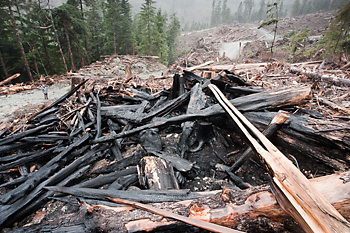 Oct 14 2010
Oct 14 2010Clearcuts blamed in First Nation flooding
KINGCOME INLET – Clearcut logging and a receding glacier were pinpointed Tuesday as probable contributors to a devastating flood which swept through the remote First Nations community of Kingcome Inlet last month.
Indian Affairs Minister John Duncan and First Nations leaders, who converged on the village to take a first hand look at the damage, said a helicopter trip up the Kingcome River Valley was startling.
“Right at the glacier is an obvious unravelling of the slopes,” said Duncan,
who announced financial help adding up to $770,000 and said a key part of
the recovery plan will be a full hydrological assessment of the valley.
“I was expecting to see a significant event. What I wasn’t expecting was to
follow mud all the way to the headwaters and major, significant issues at
the head of the glacier,” said Duncan, adding that there will be no quick
fix.
Assembly of First Nations National Chief Shawn Atleo said the situation up
the valley means the community will remain vulnerable.
“It has been severely impacted by decades of clearcut logging and, at the
head of the glacier, I saw a torrent of mud and debris,” he said.
Increased monitoring will be necessary once residents return to the village
and one of the priorities will be ensuring the helicopter pad is usable at
all times, Duncan said.
Helicopters provided the only way out for about 120 residents when water
quickly rose up to four metres in parts of the village.
Wayne Goodridge, a pilot for West Coast Helicopters, the first to fly in
amid the flooding, said water was rising so fast it was uncertain whether
the helipad behind the school would remain usable.
“It was up to almost the top of the helipad – almost 15 feet. If it had gone
on any longer we would have been plucking them off the rooftops,” he said.
Apart from a handful of members of the Dzawada’enuxw First Nation who stayed when the water rose, most are now evacuated to Alert Bay, where residents are staying with friends and relatives.
In Kingcome Inlet, porches and steps have been knocked off homes, which are built on stilts to withstand regular, smaller floods. Mud fills crawl spaces and propane tanks lie at drunken angles.
Even though many electric meters were underwater, power has stayed on and Tuesday, as assessors and electrician pored over wiring and looked at other safety issues, Duncan said repair work could start on many of the homes.
“The sooner we can get people back in the community the better we will be.
Band council chairman Joe Willie said that although people are anxious to
get home, he is not yet sure it is safe.
Willie said he is pleased with support being offered by the federal
government, but the immediate offer of $100,000 for assessments and social
services help and $20,000 per house is not likely to go far. “We are an
isolated place and it costs a lot of money just to get materials in,” he
said. “Only one barge has agreed to come up the river. The rest wouldn’t
risk coming up the river.”
Although the river level has dropped, debris has collected in different
areas, creating hazards for boats. The small boats travelling the muddy
river take passengers to an open area of Broughton Archipelago to get on a
larger vessel.
The federal government is investigating building a road into the area and
about $900,000 has been spent on engineering costs, Duncan said.
Others would like to see logging companies, which have taken so much out of the area, help pay for some of the flood costs. Dave Darwin, who looks after Kingcome Inlet’s power, said the valley bottom was first stripped of all its old growth trees and then logging companies clearcut beside the main river and the tributaries. The river can no longer meander as it used to, he said.
“Maybe we can get some environmental group to finance a lawsuit,” he said.
Chief Bob Chamberlin, Musgamagw-Tswataineuk Tribal Council chairman, said the provincial government has some responsibility because it oversees
forestry. “The provincial government has enjoyed unlimited revenue from this place with no return to the First Nation that holds title. I think that
would be an interesting conversation,” he said.
However, the immediate concern has to be those driven from their homes,
Chamberlin said. “It has been 17 days now and every day we wait it’s going
to get worse,” he said. “There are 30 children displaced from their homes
and their community and we need to make proper plans.”






